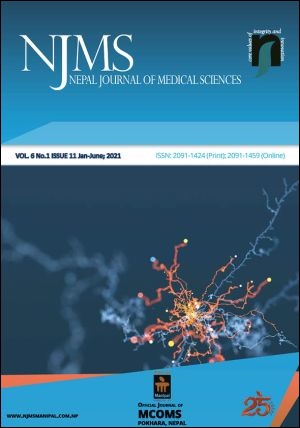Effect of Cholecystectomy on Serum Lipids and Blood Glucose (Hospital Based Observational Prospective Study)
DOI:
https://doi.org/10.3126/njms.v6i1.36725Keywords:
Atherogenic Index, Cholelithiasis, Cholecystectomy, DyslipidemiaAbstract
Introduction: Association between cholelithiasis and dyslipidemia has been shown in many studies. Recent studies have shown improvement in lipid profile following cholecystectomy. This study aimed to determine the changes in lipid profile and blood glucose level after cholecystectomy.
Methods: Seventy-three patients of cholelithiasis were studied prospectively. Total cholesterol (TC), triglycerides (TG), high-density lipoprotein cholesterol (HDL-c), low-density lipoprotein cholesterol (LDL-c), atherogenic index (AI) and fasting blood sugar (FBS) levels were estimated pre-operatively. Further, the same parameters were studied after cholecystectomy after one week and one-month intervals. None of the patients received any lipid-lowering drug or dietary restriction. Results were analysed and compared.
Results: Of the 73 patients with cholelithiasis, 66% were female and 34% male. The mean age of patients was 40.53± 13.16 years. 56% of patients with cholelithiasis had a deranged lipid profile. TC was significantly decreased at one week (p=0.002) and one month (p=0.00) interval after cholecystectomy while TG levels also decreased significantly at one month postoperative (p=0.001). There were no significant differences in LDL-c however improvement was seen on HDL-c. Blood glucose level also increased significantly (p=0.028) after one month of cholecystectomy.
Conclusion: Cholelithiasis is associated with an abnormal lipid profile. Cholecystectomy leads to a significant decrease in some of the parameters of lipid profile and the atherogenic index. The presence of gall stones thus should be perceived in the context of metabolic syndrome, which may be investigated and treated.
Downloads
Downloads
Published
How to Cite
Issue
Section
License
Copyright © by Nepal Journal of Medical Sciences. The ideas and opinions expressed by authors of articles summarized, quoted, or published in full text in this Journal represents only opinions of authors and do not necessarily reflect the official policy of Nepal Journal of Medical Sciences or the institute with which the author(s) is (are) affiliated, unless so specified.




